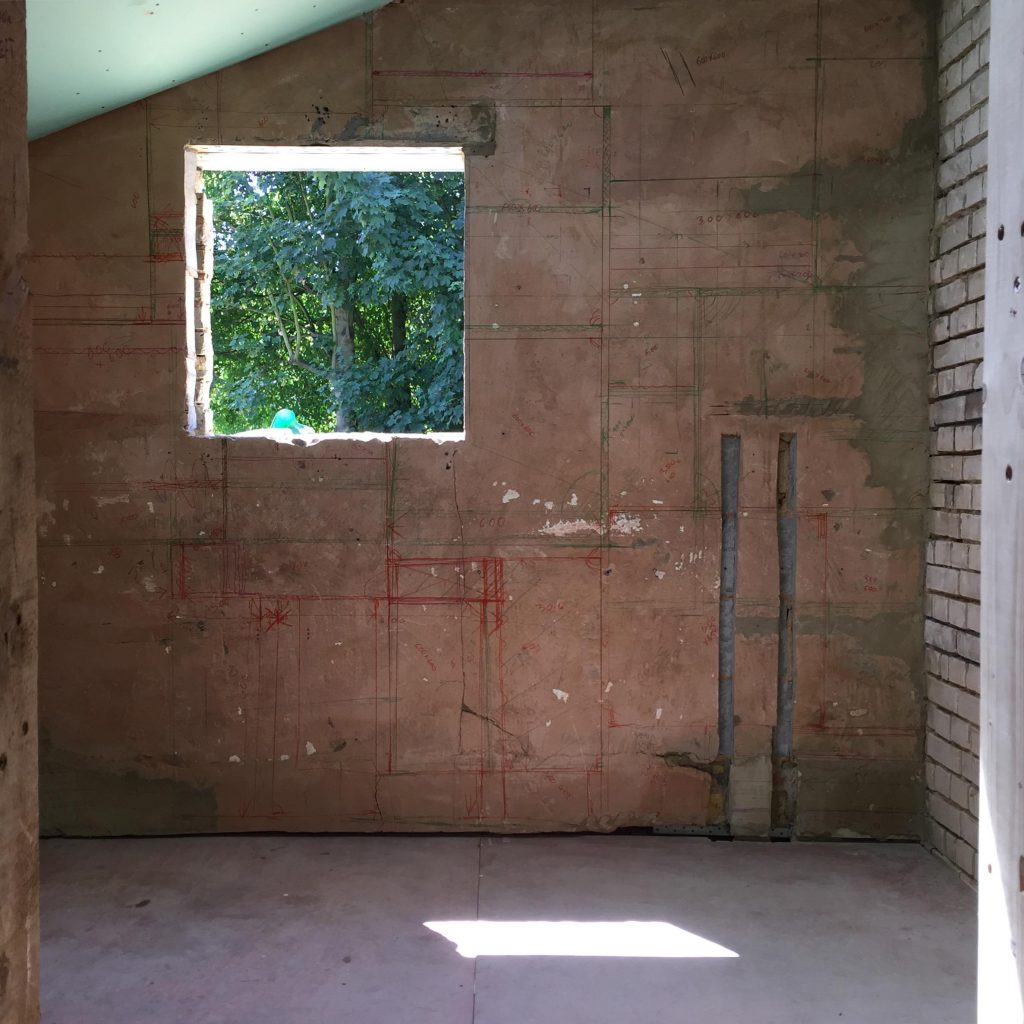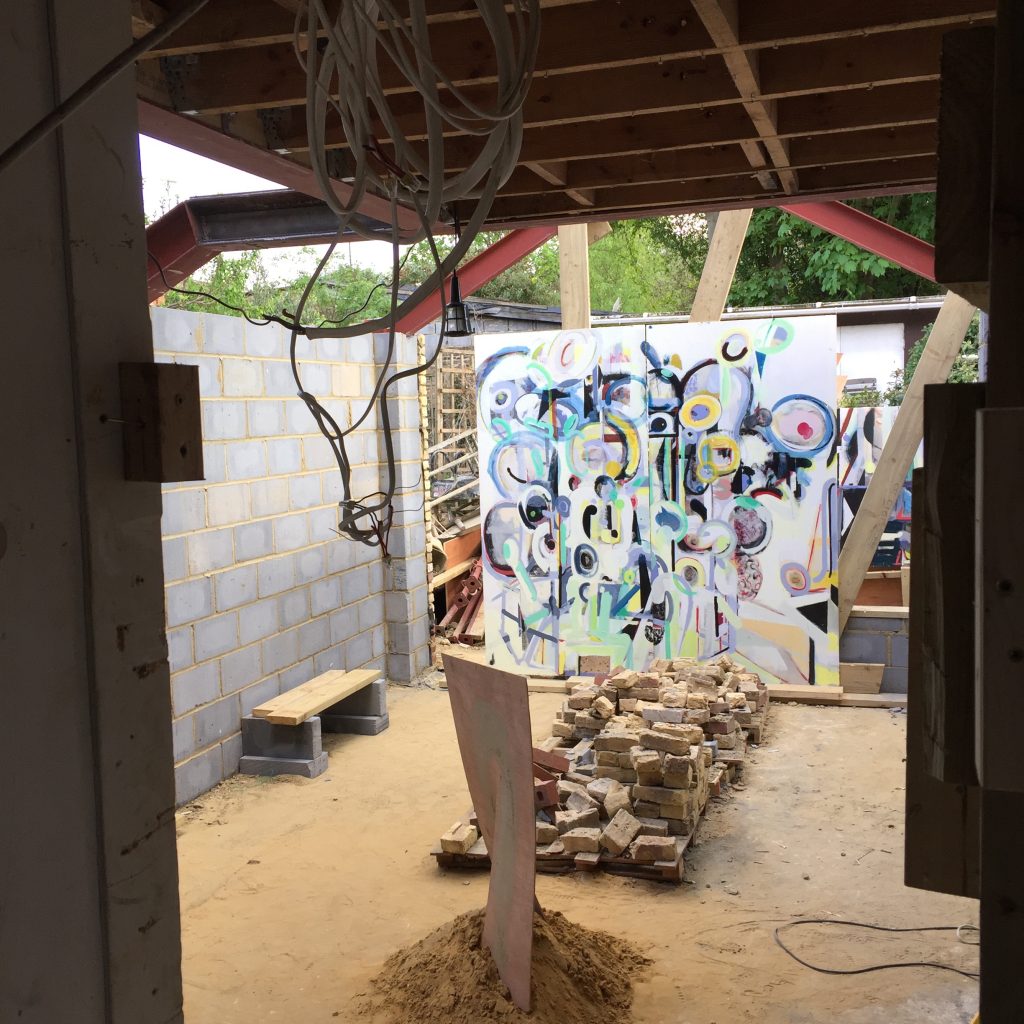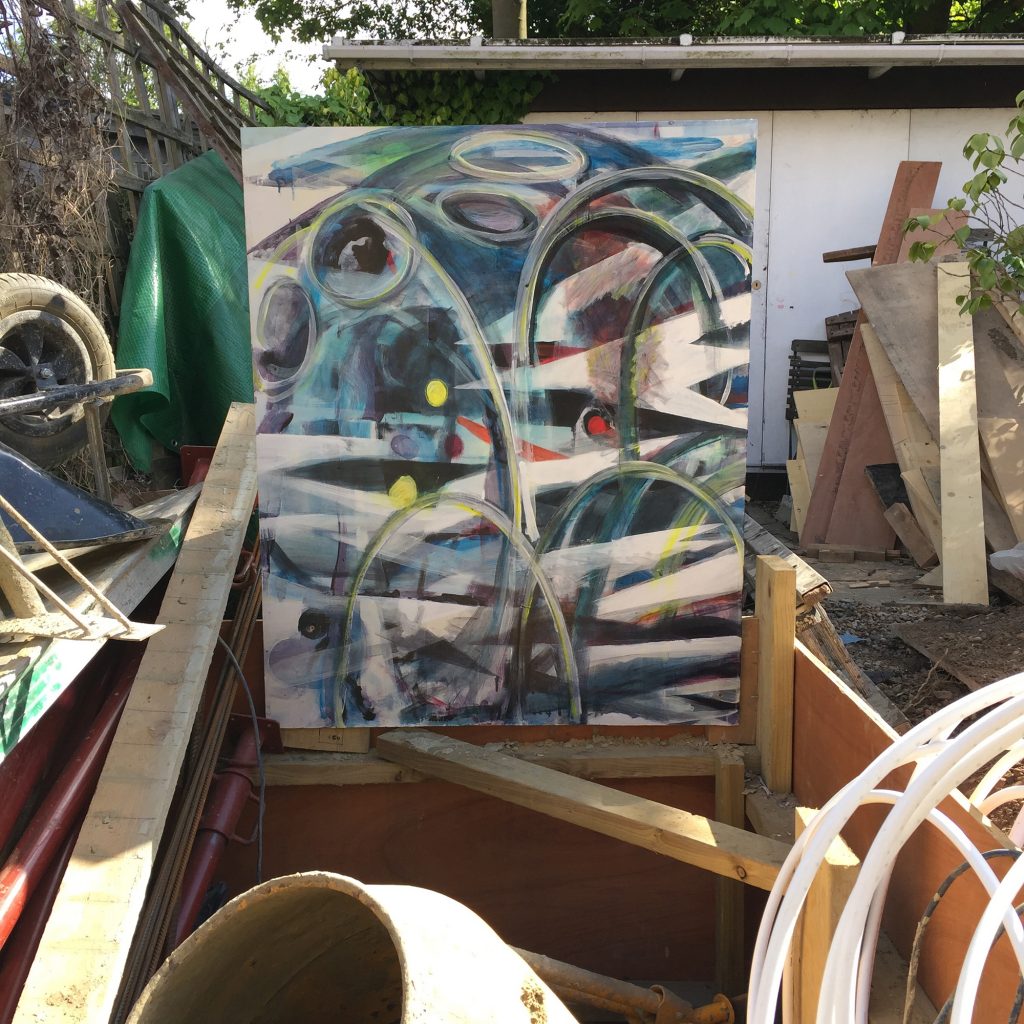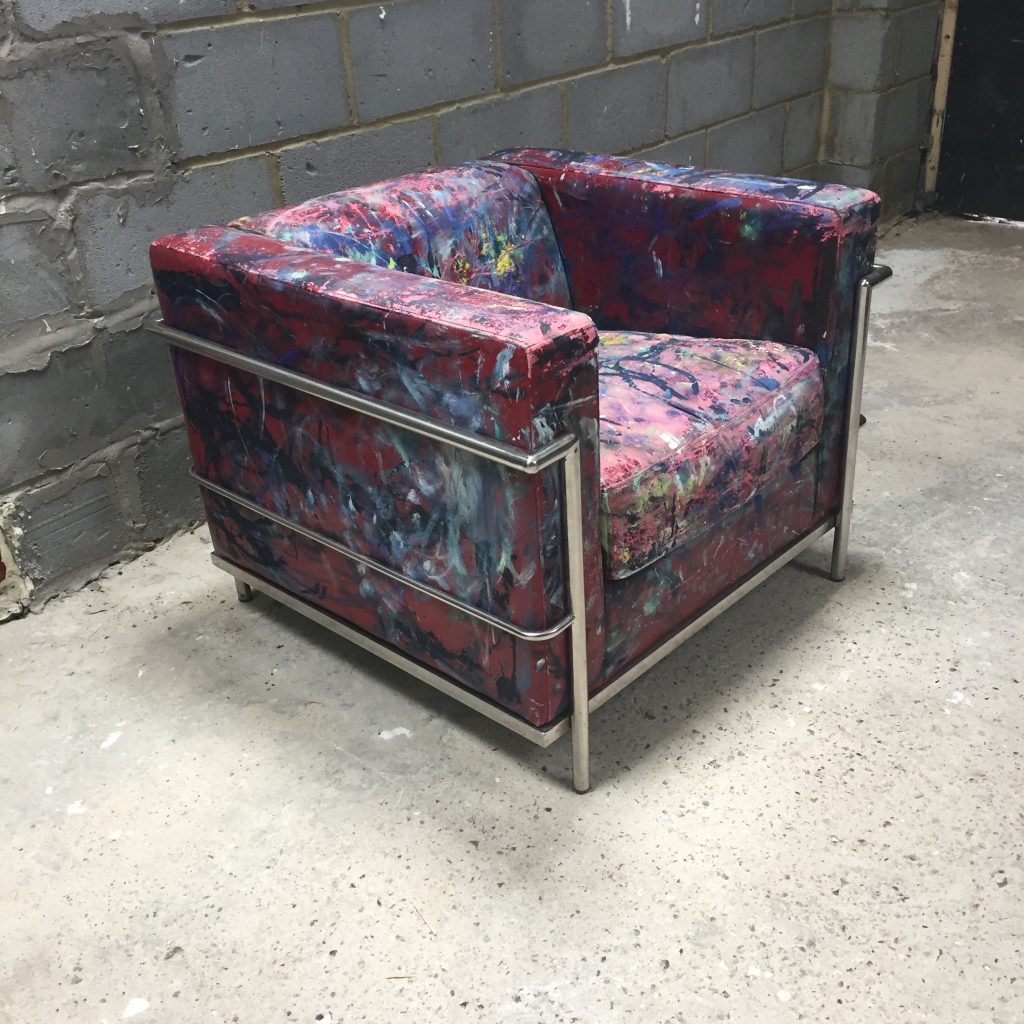EC and Simon Haddock discuss ‘FamilyHouseSpace’
EC: Whose art or ideas have shaped your thinking in setting up FHS?
SH: There is a history of arranging art and objects that have a significance that is more than functional; and one person in the 20th Century who changed the way we consider the gallery space is Marcel Duchamp. In making the appropriation of an object into an art work, he made the placement of that object into a considered act. In effect, he changed the idea of ‘art’ to being about the space of the gallery as much as it is about the artwork itself. Some people have seen this as the end of representation (but of course this is not true). How it affects painting, for me, is that it focuses and amplifies the importance of the hang, the placement. It makes the space of the painting, and the space it inhabits, equally important.
However revolutionary this act of ‘de-rarifying’ the process of representation, and of rendering the artist’s choice more significant, Duchamp (I suspect) inadvertently gave birth to a 20th-Century art phenomenon – the curator. It’s a fascinating thing to throw ‘meaning and counter-meaning’ all up in the air; to just pluck something from life and call it art, through artful placement. Some artists have parked their careers upon this idea. However, on closer inspection this ‘birth’ of the curator/artist is not a birth, but a reminder of the rich history of the arrangement of human artifacts.
We are all arranging our spaces to give a level of comfort and wellbeing. Move something, and it changes things. We appropriate our environments and, in a variety of ways, stamp our identities upon them. Neolithic art appears from a considerable distance in time like an articulation of a relationship with life and nature through ritual, in scratching, drawing, painting and object making. The cave appears like a ‘church’ that draws communities together. Organised religions gave us imposing architectural ‘hubs’, where the decor offered believers a visual language to underpin their belief system. Things get interesting, and more recognisable from the perspective of curatorial arrangement, when narrative takes a tentative step away from religious didacticism in the the early Renaissance: we find political painting, like Ambrogio and Pietro Lorrenzetti’s ‘Allegory of Good and Bad Government’ 1https://en.wikipedia.org/wiki/The_Allegory_of_Good_and_Bad_Government), one massive wall painting situated opposite another in a pictorial ‘faceoff’; a bandit Satan and a harmonious city state were a visual illustration, for the citizens of Siena, of the dangers that exist beyond the rule of law. Its ‘meaning’ comes out of a choreography in space.
I don’t want to get caught up too much in specifics, as this is a huge area of ideas; however, as I see it, something about the gallery, and activities within the space of the gallery, evolved from the history of this ‘meaning out of placement’. The concept was rocket-fuelled as a possibility by Marcel Duchamp in 1917, when he took a urinal, signed it with an invented name, called it ‘fountain’ and presented it for exhibition at the Society for Independent Artists.
Family House isn’t a cave, a church, a municipal building or a conventional gallery space – It’s a family house, and as an art space it will be informed by a sense of ‘place’ and ‘placement’ that has a fascinating history.
EC: What moved you to set up a gallery in your own home?
SH: I know this might sound strange but it felt like the natural and normal thing to do. I’ve really enjoyed my experiences of curating shows way back to when I was a student. It matters to me how works are arranged. When I’m visiting shows I’m always mentally rearranging them… How would I ‘take’ the space with the works given, ‘tell the story’, or bring a painting or sculpture alive through its placement.
EC: If the white cube is some kind of ‘capitalist, consumerist, product based’ approach to art, do you think that FamilyHouse is echoing some of the ideas of the gallery as ‘material’ and is related to some of the more radical artistic gestures of the 1960’s and 1970’s?
SH: I would say how we structure our personal lives is political. I’m not sure how that fits in terms of ‘radical gestures’, but certainly I’m interested in proposals that challenge the space and work off the idea of its functional nature. This could be reminiscent of the 1970’s, it’s hard to say. For me, the relevance of politics, family, communication and community is kind of the bedrock of how and why I make art; so perhaps the use of the kitchen is a natural step. It seems to me that keeping a dialogue going about the pressing cultural and political matters of our age is something that happens in a context like this, in every kitchen.
EC: Does the ‘making space’ in your paintings derive from your interest in building sites and the ‘patterns of destruction and spatial order’ that you have encountered through your exhibition building work on major show spaces?
SH: I would say there is a strong correlation between my approach to building and to painting. I worked at the Tate, the Hayward and many of the other cathedrals of art consumption in London. It’s quite a while since I did that work, and to be honest, it’s far more interesting as a memory (the actual experience was exhausting). Nevertheless, when asked to pull down some blockbuster show you’d find yourself in some amazing landscapes. I’d want to stop working on the show, and start making paintings about all those inadvertent colour relationships in piled up boards, broken structures and seas of trash. I’m not sure whether other people do this; but I can’t help finding patterns and compositions in destruction. I’m also attracted to using many of the tools and materials I use for building in my painting and installation work. In terms of process, rather than directly painting, I score, cut and sand the surface of my work. It’s a physically intrusive approach to painting and is more like building a landscape out of physical acts. Even if it’s not cutting literally, I’m cutting up space with paint.
As I’ve been building FHS I feel ideas for paintings and installations everywhere. It’s highly distracting. In some ways the ‘space’ in my painting too has a strong link to the spaces in FHS. It’s not always conscious. I often build a kind of canopy or roof over the activity in my work like an intergal framing of a landscape, in an underground carpark of some kind or in a tent. With FHS, out of necessity I found myself actually building a real roof over FamilyHouse.Space.
EC: In the video ‘Conical Intersect / Gordon Matta-Clark & Bruno de Witt /1975’ 2 https://randomarchitecturememories.com/home/conical-intersect-gordon-matta-clark-bruno-de-witt-1975Matta-Clark says of the work that ‘the first thing one notices is that violence has been done. Then the violence turns into visual order and, hopefully, then to a sense of heightened awareness…. You see that light enters places it otherwise couldn’t. Angles and depths can be perceived where they should have been hidden. Spaces are available to move through that were previously inaccessible…. My hope is that the dynamism of the action can be seen as an alternative vocabulary with which to question the static, inert building environment.’
Are those words relevant to your plans for FHS? Will the space change and will the sense of a bulding site be cleared away for something more ‘settled’?
SH: I’m glad you mention Matta-Clark’s work. His approach to cutting and smashing through the architctural frame certainly influenced me as a painter. His “interventions” for me are always about perspective, of looking through and redefining context. I see this in the way I treat surface. I sometimes feel that every work is on the edge on being obliterated. Somehow, if it’s not, I lose interest.
Watching ‘Conical Intersect’ again from your link also made me realise how, with FHS, it’s actually the building process that is inserting itself into painting or installation, rather than art “interjecting” into an existing structure, as occurs when Matta-Clark punches through the walls of a soon-to-be-demolished building. The transformations of space are happening on a subtle and sometimes invisible scale. It’s hard to explain, but throughout the building process, almost in the walls themselves, there have been some key ‘solutions’ to things: things that give the space these ‘angles and depths (that) can be perceived where they should have been hidden’. Those ideas are part of the fabric of FHS. I want to make a show based on these ideas of ‘intervention’ and ‘invisibility’.
EC: How do you think people will respond to a gallery space being in such an intimate and private setting, and what challenges do you think a gallery operating in a domestic context might face?
SH: It’s hard to say… I did half consider keeping a clean ‘everyday life free’ area of the house to exhibit in but that didn’t feel right. I want the exhibition space in the centre of domestic activity and for it to interact with the patterns of everyday life. I’ve not heard of anyone who has done this so directly and deliberately – there have been a fair few galleries starting up in homes but not specifically in kitchens as far as I know.
EC: Will you have some kind of schedule or way of controlling numbers of visitors etc?
SH: The space will be open two days a week and by appointment Friday and Saturday.
EC: Will you be taking proposals for shows from other artists?
SH: Absolutely – that’s the idea.
EC: How have you used the space so far?
SH: I’ve done a couple of experimental shows in the space focusing on different aspects of my work. ‘Building Site Show’ was put together when the space still didn’t have a roof or completed walls. In this show I used the broken bricks piles of sand in a dialogue with, and at times almost in conflict with, the paintings.
With ‘T.T.’ in April last year, I explored tools and the intimate relationship that develops between the everyday and consumerism. In ‘Sedent Pleasures’ I explored one particularly popular sedentary act and leisure activity, the game console, and its use. Using a kind of perspective and simple cause and effect, darts can be thrown into and at a painted frame. This is a computer game reduced to looking, and to one simple binary action.
EC: What plans and aims do you have for the future of FamilyHouse.Space?
SH: The first group project is called ‘Tetris Hang’ and is open now until 13 October. It might sound like I’m a computer game obsessive but this really isn’t the case (I only play chess). I am interested in the way games appropriate and change the perception of certain actions and the way a set of rules or precepts create possibilities. This is the case with ‘Tetris Hang’: I’ve asked 21 artists to make 40 x 40 cm wall based artworks. The result will be a ‘group painting’ and this arrangement of paintings will be rehung daily. It’s an experiment in visual language. The artists involved are relinquishing the basic convention of exhibiting, that their painting will remain in one place for the duration of the show. ‘Tetris Hang’ will go further than this and rotate, if their composition allows for this. With each day’s composition there will be works that will not not be included, and that will subsequently disappear from the show.
I have a lot of material I’d like to explore, and ideas for future events and exhibitions that will not be quite as painterly as ‘Tetris Hang’. I plan drama performances, dance projects, film events and food-related experiences.
https://www.facebook.com/FamilyHouse.Space/?ref=br_rs
instagram : simon_haddock
#familyhousespace
Works in progress at FHS, 2017
Simon Haddock, ‘Left’ (2017), sand, cigarette filters, zinc plate and acrylic in sand, dimensions variable
3 thoughts on “EC and Simon Haddock discuss ‘FamilyHouseSpace’”
Comments are closed.




Great interview. Interesting and well focused questions and good to hear how Simon plans to use the space, and its intersection with the domestic.
Thanks Nick. I’m looking forward to seeing what Simon gets up to next. I think the space and Simon’s ideas have a sense of generosity and expansiveness.